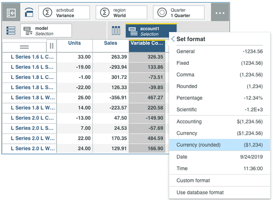We have successfully integrated IBM watsonx Orchestrate with IBM Planning Analytics to allow...
Analyzing Cell History in IBM Planning Analytics
In this blog we will explore the ability to view the audit trail of changes made to individual data cells or ranges of cells by leveraging IBM PA drill-through
Transaction and Edit History in IBM Planning Analytics
In the existing version of IBM Planning Analytics, there is no easy way for users to understand the history of an input cell and analyze how the current value was created. IBM PA can write every change in the system in a Transaction Log so the data is available. However, that Transaction log is not available to view for the average user from the front-end in an easy manner. The logs can be analyzed by an administrator and can also be used to restore prior values / versions but this is a technical process that is not useful to an average user
Cell History Using the IBM Planning Analytics Drill-Through Function
ACG’s TLog exposes the list of transactions to the end user from the drill-down menu using a right click of the mouse directly from the front end. The solution relies on a set of objects in the back-end that are native to IBM PA to bring the transactions from the log to a table and make it accessible to the end user.

Scenario Level of Detail
The drill through capability will be different depending on the scenario that is being analyzed:
- Drill through to actuals will show the GL or other level of detail that has been loaded from the source system. Commonly, this will put back subledger or Journal entry transactions from the ERP system or DW
- Drill through for any forward-looking scenario (Budget, Forecast, etc.) will show the cell history of how the number has been changed over time
Both scenario drills will work the same from the same front-end menu for every user.
Cell History Based on Type of Input / Calculation
For forward looking scenarios, the drill down function is available regardless of how that cell is populated:
- If the cell is input or populated by a TI process executed by a user, then Cell History will return all the entries by users per the example above
- If the cell is populated using a scheduled chore – the cell history will show that a process populated the cell.
- If the process is a calculation that relies on a set of inputs and parameters, the same Cell History drill-down will be available for those items to understand the history of the calculation / assumptions
- If the cell is derived by a Rule, then the calculation can be viewed using Trace Cell from the right click menu. IBM PA provides a narrative description of the rule using Gen AI in plain terms understandable to the user. If there are parameters to the calculation that are input, these can be audited using Cell History also.
Other Solution Considerations
Some additional considerations of this solution include the following:
- Drill through is available from a leaf element OR a summary level. The drill menu is the same, the summary drill will show changes to all underlying elements
- The solution can be implemented for large instances with multiple input cubes. All transactions can be stored in a single table to streamline the drill through for developers and users
- Drill can be enabled / disabled for selected cells or intersections
Technical Implementation Detail
A detailed implementation walk through, including script samples and design considerations is available for download on this link. If you would like to discuss this solution in more detail please reach out to info@acgi.com.



